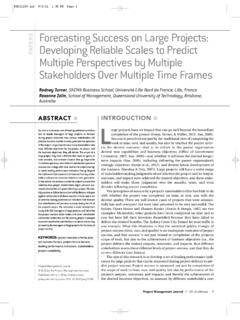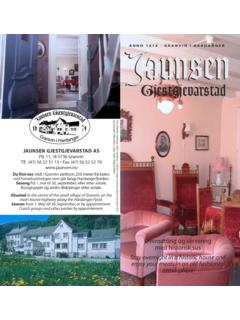Transcription of Managing Stakeholders in Megaprojects The MS …
1 Managing Stakeholders in Megaprojects The MS Working Group Report Edited by: Paul Littau Authors: Paul Littau,Ivana Burcar Dunovi ,Louis-Francois Pau, Mauro Mancini, Ana Irimia Di- eguez, Carmen Medina-Lopez, Konrad Spang, Agnese Travaglini, Raffaello Colombo, Maja-Marija Nahod, Agnieszka Lukasiewicz 2. COST European Cooperation in Science and Every year thousands of European scientists Technology is an intergovernmental framework benefit from being involved in COST Actions, al- aimed at facilitating the collaboration and net- lowing the pooling of national research funding working of scientists and researchers at Euro- to achieve common goals.
2 Pean level. It was established in 1971 by 19 mem- ber countries and currently includes 35 member As a precursor of advanced multidisciplinary research, countries across Europe, and Israel as a coope- COST anticipates and complements the activities of rating state. EU Framework Programmes, constituting a bridge . towards the scientific communities of emerging coun- COST funds pan-European, bottom-up networks of tries. In particular, COST Actions are also open to par- scientists and researchers across all science and tech- ticipation by non-European scientists coming from nology fields.
3 These networks, called COST Actions , neighbour countries (for example Albania, Algeria, Ar- promote international coordination of nationally-funded menia, Azerbaijan, Belarus, Egypt, Georgia, Jordan, research. Lebanon, Libya, Moldova, Montenegro, Morocco, the Palestinian Authority, Russia, Syria, Tunisia and By fostering the networking of researchers at an interna- Ukraine) and from a number of international partner tional level, COST enables break-through scientific de- countries. COST s budget for networking activities has velopments leading to new concepts and products, the- traditionally been provided by successive EU RTD.
4 Reby contributing to strengthening Europe s research Framework Programmes. COST is currently executed and innovation capacities. by the European Science Foundation (ESF) through the COST Office on a mandate by the European COST s mission focuses in particular on: Commission, and the framework is governed by a + Building capacity by connecting high quality scientific Committee of Senior Officials (CSO) representing all its communities throughout Europe and worldwide; 35 member countries. + Providing networking opportunities for early career investigators; More information about COST is available at + Increasing the impact of research on policy makers, regulatory bodies and national decision makers as well as the private sector.
5 University of Leeds Through its inclusiveness, COST supports the integra- Published by the University of Leeds, April 2015. tion of research communities, leverages national re- search investments and addresses issues of global re- ISBN 978-0-9576805-2-4. levance. While the publisher and author have used their best efforts in preparing this book, they make no representations or warranties with respect to the accuracy or completeness of the contents of this book and specifically disclaim any implied warranties of merchantability or fitness for a particu- lar purpose. No warranty may be created or extended by sales represen- tatives or written sales materials.
6 The advice and strategies contained herein may not be suitable for your situation. You should consult with a professional where appropriate. Neither the publisher nor authors shall be liable for any loss of profit or any other commercial damages, including but not limited to special, incidental, consequential, or other damages. All rights reserved. No part of this publication may be reproduced, stored in a retrieval system or transmitted, in any form or by any means, electronic, mechanical, photocopying, recording or otherwise, without the prior permis- sion. 3. Content I. 3. 1.
7 Managing Stakeholders .. 4. 2. Research Methods .. 5. 3. Results 18. 4. Interpretation & Summary .. 22. 5. Recommendations .. 24. References .. 28. 4. Managing Stakeholders Aim & Background of the Working Group stakeholder management (SM) in Megaprojects was established as one of four working groups within the Megaproject COST-Action. The critical importance of stakeholder management in Megaprojects was identified in the first phase of the COST-Action s research by case studies. It was obvious that stakeholder have huge impact on the performance of Megaprojects . Thus, this working group started with the focus on this specific aspect of megapro- ject management.
8 Thereby, the focus was aligned with the overall aim of the COST- Action: " to understand how Megaprojects can be designed and delivered more effectively to ensure their effective commissioning within Europe. Effective design and delivery means not only insuring that the megaproject is deli- vered on-time and to budget but that it satisfies the societal and com- mercial needs that motivated its creation and that it continues to do so throughout its entire life-cycle". Thus, two guiding questions were developed for this working group: 1. What are the problems that occur with Stakeholders in Megaprojects ?
9 2. How to manage those problems and Stakeholders ? To answer these questions different methods have been applied all based on a case study approach which was the data foundation of this COST-Action. The me- thods applied and the results reached will be presented in this report in the following pages. There were various ways possible to the group to choose of how to work together: group meetings, small meetings, short term scientific missions (STSMs), confe- rences, student projects, etc.! 5. Research Methods The Interdepence between the different methods To address the research question properly, different methods have been applied to cover different aspects of the problem.
10 A general approach was developed and con- tained two methodological ways in order to understand how Stakeholders impact megaproject performance. The first methodology way focused to uncover how project context und culture influence Stakeholders behavior whereas the second addressed stakeholder interactions and thus used network analysis. Furthermore, a framework was needed to measure stakeholder impact on megaproject perfor- mance. The Figure 1 explains the connection between the clustering of Stakeholders ac- cording cultural context, stakeholder network analysis and megaproject impact.










